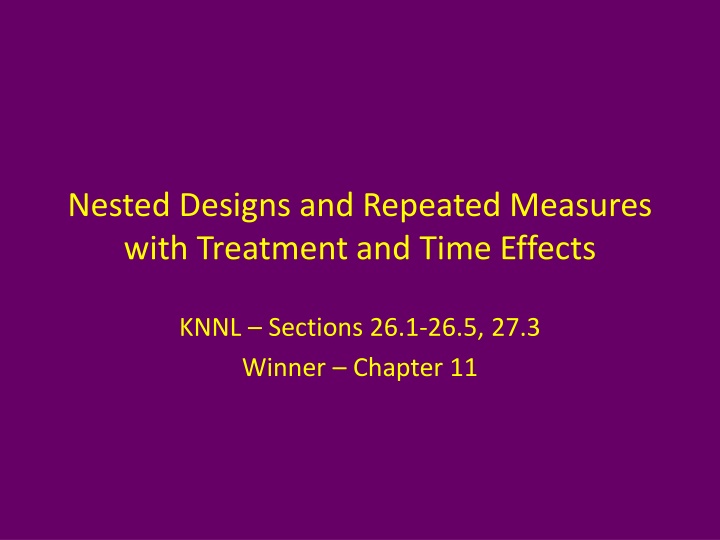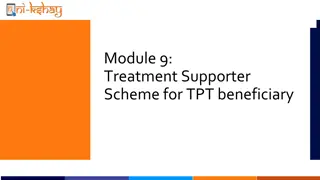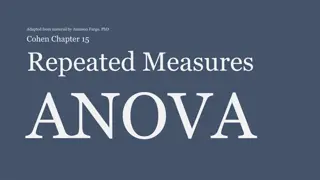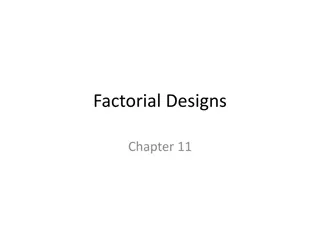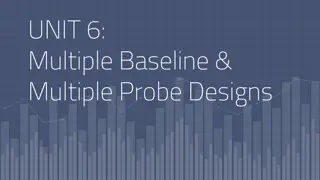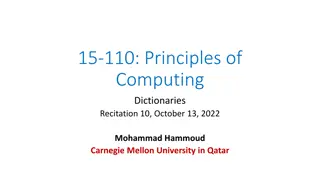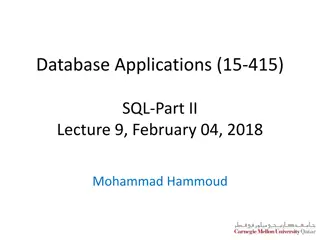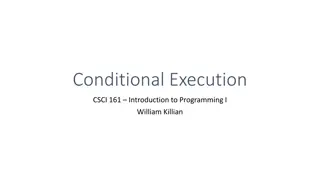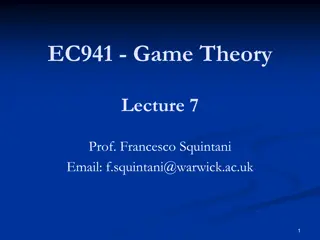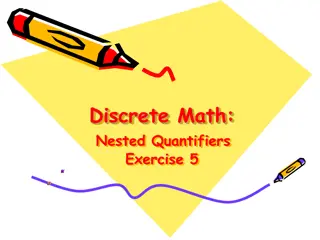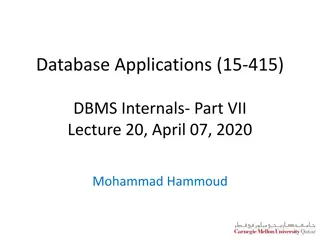Nested Designs and Repeated Measures with Treatment and Time Effects
Factors in nested designs involve levels within different levels of another factor. Understanding nesting factors can help in analyzing complex experimental setups efficiently. This model explores the balanced case of a 2-factor nested design, discussing fixed and random factors and their effects on the analysis of variance. Estimators and F-tests play a crucial role in assessing treatment and time effects in such designs, providing insights into the significance of factors and interactions.
Download Presentation

Please find below an Image/Link to download the presentation.
The content on the website is provided AS IS for your information and personal use only. It may not be sold, licensed, or shared on other websites without obtaining consent from the author.If you encounter any issues during the download, it is possible that the publisher has removed the file from their server.
You are allowed to download the files provided on this website for personal or commercial use, subject to the condition that they are used lawfully. All files are the property of their respective owners.
The content on the website is provided AS IS for your information and personal use only. It may not be sold, licensed, or shared on other websites without obtaining consent from the author.
E N D
Presentation Transcript
Nested Designs and Repeated Measures with Treatment and Time Effects KNNL Sections 26.1-26.5, 27.3 Winner Chapter 11
Nested Factors Factor is Nested if its levels under different levels of another (Nesting) factor are not the same Nesting Factor School, Nested Factor Teacher Nesting Factor Factory, Nested Factor Machinist If Factor A (Nesting) has a levels and Each Level of A has b levels of Factor B (Nested), there are a total of ab levels of Factor B, each being observed n times A1 A2 A3 Factor A Factor B B2(1) B2(2) B2(3) B1(1) B1(2) B1(3) Y211 Y311 Y312 Y111 Y112 Y321Y322 Replicates Y121 Y122 Y222 Y212 Y221 Note: When Programming, give levels of B as: 1,2,...,b,b+1,...,2b,...(a-1)b+1,...,ab
2-Factor Nested Model Balanced Case = + Factor A at levels with means: Factor B with ab = + + a i i levels ( disinct levels w/in each level of A) with means: b = + ( ) = ( ) j i ( ) j i ij i ij i ij i a b = = A and B Fixed Factors 0 0 i ( ) j i i = = 1 1 = i + j ( ) = + = = + + = = 2 1,..., ; 1,..., ; 1,..., ~ 0, independent Y i a j b k n N ( ) j i ijk ij ijk ij i ijk ijk ( ) + + 2 ~ , independent Y N ( ) j i ijk i a ( ) = 2 A Fixed and B Random: 0 ~ 0, independent N ( ) j i ( ) j i i = 1 i + = = = 2 2 ', ', ' i i j i j j k j k k ( ) + + = = = 2 2 2 ~ , , ', ', ' Y N Y Y i k ' ijk i ijk ijk 0 otherwise ( ) ( ) = = = = 2 2 A and B Random ~ 0, indep ~ 0, indep N N ( ) j i ( ) j i i + + + = = 2 2 2 ', ', ', i ', ', ', ' ' i i i i j i j i j j k j k j k k 2 2 ( ) + + = 2 2 2 ~ , , Y N Y ' ' ' i j k Y ijk ijk 2 , ' , ' k k k k , ', j j 0 ', i
Estimators, Analysis of Variance, F-tests ^ ^ ^ = = = Y Y Y Y Y i ij i i ( ) j i ( ) ( ) ) ^ ^ ^ ^ + + = + + = Fitted Values: = Y Y Y Y Y Y Y ijk i ij i ij i ( ) j i ( a b n ^ 2 ( ) = = = = Residuals: 1 e Y Y Y Y SSE Y Y df ab n ijk ij ij ijk ijk ijk ijk E = = = 1 1 1 i j k ( ) a 2 = = Factor A Sum of Sq uares: 1 SSA bn Y Y df a i A = 1 i ( ) a b 2 ( ) = = Factor B Within A Sum of Squares: ( ) 1 SSB A n Y Y df a b ij i ( ) B A = = 1 1 i j A Fixed, B Fixed A Fixed, B Random A Random, B Random a a 2 i 2 i bn bn = + = + + = + + 2 2 2 2 2 2 = = 1 1 i i E MSA E MSA n E MSA n bn ( ) ( ) 1 a 1 a a b 2 j i n ( ) = = 1 1 i a b j = + = + = + 2 2 2 2 2 ( ) ( ) ( ) E MSB A E MSB A n E MSB A n ( ) ( ) ( ) 1 = = = 2 2 2 E MSE E MSE E MSE MSA MSE MSA MSB A ( ) MSB A MSE MSA MSB A MSB A MSE = = = = = = = = = = 2 : ... 0 : : ... 0 : : 0 : H TS F H TS F H TS F 0 1 0 1 0 a A a A A ( ) ( ) ( ) ( ) MSB A MSE = = = = = = = = 2 2 : ... 0 : : 0 : : 0 : H TS F H T S F H TS F 0 1(1) ( ) b a ( ) B A 0 ( ) ( ) B A 0 ( ) ( ) B A
Fixed Effects Model (A and B Fixed) MSA TS F RR F MSE MSE Y s Y bn bn ( ) = = = = Factor A: : ... 0 : : 1 ; 1, 1 H F a ab n 0 1 a A A 2 = = + = = 2 2 E Y i i i i i a = Contrasts among Means of A: 0 c i = 1 i a a a a MSE bn ^ L ^ L = = i = = 2 2 i L c c c Y s c A i A A i i i i = = = = 1 1 1 1 i i i i a MSE bn ^ L ( ) ( ) ( ) ( ) 2 i 1 10 0% CI for : 1 / 2 ; 1 L t ab n c A A = 1 i ( ) 1 a a a = = 2 i All Possible Comparisons among pairs of means of A: 2 c C A 2 = 1 i ( ) ( ) 2 MSE bn MSE bn ( ) ( ) ( ) ; , a ab n Tukey: 1 1 Bonferroni: 1 ; 1 Y Y q Y Y t ab n ' ' i i i i 2 C A ( ) MSB A MSE ( ) ( ) = = = = Factor B(A): : ... 0 : : 1 ; 1 , 1 H TS F RR F F a b ab n 0 1(1) ( ) b a ( ) B A ( ) B A 2 MSE n = = + + = = 2 2 E Y Y s Y ij ij ij ( ) j i ij i n ( ) 1 b b = All Possible Comparisons among pairs of means of B within a give n level ( ) of A: i C ( ) B A 2 ( ) ( ) 2 MSE n MSE n ( ) ( ) ( ) ; , b ab n Tukey: 1 1 Bonferroni: 1 ; 1 Y Y q Y Y t ab n ' ' ij ij ij ij 2 C ( ) B A
Mixed Effects Model (A Fixed and B Random) MSA MSB A n bn ( ) = = = = Factor A: : ... 0 : : 1 ; 1, 1 H TS F RR F F a a b 0 1 a A A ( ) + 2 2 ( ) MSB A bn ( ) = = + = = 2 2 E Y Y s Y i i i i i ( ) 1 a a a = = 2 i All Possible Comparisons among pairs of means of A: 2 c C A 2 = 1 i ( ) ( ) ( ) 2 ( ) MSB A bn MSB A bn ( ) ( ) ( ) ; , a a b Tukey: 1 1 Bonferroni: 1 ; 1 Y Y q Y Y t a b ' ' i i i i 2 C A ( ) MSB A MSE ( ) ( ) = = 2 Factor B(A): : 0 : : 1 ; 1 , 1 H TS F RR F F a b ab n 0 ( ) ( ) B A ( ) B A 1 n 1 n = + = + = 2 2 2 2 ( ) ( ) E MSB A n E MSE E MSB A E MSE ( ) ( ) ( ) 2 2 s 1 n 1 n ( ) = = 2 ( ) Approximate df (Satterthwaite): s MSB A MSE df ( ) ( ) 2 2 ( ) MSB A n a b MSE n ab n + ( ) ( ) 1 1 2 2 df s df s ( ) ( ) ( ) ( ) ( ) 2 Approximate 1 100% CI For : , a ( ) 2 2 1 ; ; df df ( ) ( ) 2 2
Random Effects Model (A and B Random) MSA MSB A ( ) = = 2 Factor A: : 0 : : 1 ; 1, 1 H TS F RR F F a a b 0 A A ( ) = + + = + 2 2 2 2 2 ( ) E MSA n bn E MSB A n ( ) ( ) 1 1 + = 2 ) ( ) E MSA E MSB A bn bn ( ) s + 2 2 1 1 = = 2 ( ) Approximate df (Satterthwaite): MSB A s MSA df A 2 2 bn bn ( ) MSA bn a MSB A bn a b ( ) 1 1 2 2 df s df s ( ) 2 Approximate 1 100% CI For : , A A 2 2 1 ; ; df df A A 2 2 Factor B Within A is same as in Mixed Effects Model
Repeated Measures with Treatment and Time Goal: Compare a Treatments over b Time Points Begin with nT = as Subjects, and randomly assign them such that s Subjects receive Treatment 1, ... s Subjects receive Treatment a Each Subject receives 1 Treatment (not all Treatments) Each Subject is observed at b Time points Treatment is referred to as Between Subjects Factor Time is referred to as Within Subjects Factor Treatment and Time are typically Fixed Factors Subject (Nested within Treatment) is Random Factor Generalizes to more than 1 Treatment Factor
Statistical Model ( ) = + + + + + = = = 1,..., ; 1,..., ; 1,..., Y i s j a k b ( ) i j ijk j k ijk jk th th th Measurement on Subject within the Treatment at the Time Point Y i i k ijk ( ) 2 Overall Mean ~ 0, ( independent ) independent N ijk 2 Subject Effects ~ 0, N ( ) i j ( ) i j ( ) i j ijk a = Treatment Effects 0 j j = 1 j b = Time Effects 0 k k = 1 k a b ( ) ( ) ( ) = = TreatmentxTime Interaction Effects 0 jk jk jk = = 1 1 j k + + = = = = = 2 2 ', ', ', ', ' ' i i i j i j j k j k k k ijk E Y ijk Y ( ) = + + + = + = 2 2 2 2 , Y ' ' ' i j k Y j k ijk jk 0 otherwise 2 2 2 + M 2 Y Y L L O L 1 ij 2 M 2 2 2 M ( ) ( ) 2 ij M + + + + = 2 2 ~ , Y N ijk j k jk + 2 2 2 2 Y ijb
Analysis of Variance & F-Tests a 2 j sb ( ) a 2 = 1 j = = = + + 2 2 Treatment (Factor A): 1 SSA sb Y Y df a E MSA b j A 1 a = 1 j b 2 k sa ( ) b 2 = = = + 2 = Time (Factor B): 1 1 k SSB sa Y Y df b E MSB k B 1 b = 1 k a b ( ) 2 s jk ( ) a b 2 ( )( ) = = 1 1 j a k = + = = + 2 Trt x Time (AB): 1 1 SSAB s Y Y Y Y df a b E MSAB jk j k ( )( ) AB 1 1 b = = 1 1 j k ( ) s a 2 ( ) = = = + 2 2 Subject(Trt) (S(A)): ( ) 1 ( ) SSS A b Y Y df a s E MSS A b ij j ( ) S A = = 1 1 i j ( ) s a b 2 ( )( ) = + = = 2 TimexSubj(Trt) (B.S(A)): . ( ) 1 1 . ( ) SSB S A Y Y Y Y df a b s E MSB S A ijk ij jk j . ( ) B S A = = = 1 1 1 i j k ( ) = = = A B AB Tests: : all 0 : all 0 : all 0 H H H 0 0 0 j k jk MSA MSS A MSB MSAB MSB S A = = = Tests Statistics: F F F A B AB ( ) . ( ) . ( ) MSB S A ( ) ( )( ) ( )( ) ( )( ) Rejection Regions: 1 ; 1, 1 1 ; 1, 1 1 1 ; 1 1 , 1 1 F F a a s F F b a b s F F a b a b s A B AB
Comparing Treatment and Time Effects No Interaction Treatment (Factor A) Effects when No Interaction Between Treatment and Time: ( ) ( ) MSS A sb ( ) Tukey Method: 1 ; 1 Y Y q a s ' j j Bonferroni Method: ( ) 2 ( ) ( 1) MSS A sb a a ( ) = 1 ; 1 Y Y t a s C ' j j A 2 2 C A Tim e (Factor B) Effects when No Interaction Between Treatment and Time: ( ) . ( ) sa MSB S A ( )( ) Tukey Method: 1 ; 1 1 Y Y q a b s ' k k Bonferroni Method: ( ) 2 . ( ) sa ( 1) MSB S A b b ( )( ) = 1 ; 1 1 Y Y t a b s C ' k k B 2 2 C B
Comparing Trt Levels w/in Time Periods Comparing Treatment Levels Within Time Levels: Bonferroni: ( ) ( ) + 2 ( ) 1 . ( ) MSS A b bs MSB S A ( ) 1 ; Y Y t df . . ' j k jk 2 C A with approximate df: b 2 + ( 1) . ( ) ( ) b MSB S A MSS A = df 2 2 ( 1) ( . ( ) 1) s ( ) 1) MSB S A MSS A a s + 1)( ( a b
Elements of Split-Plot Designs RBD Case Split-Plot Experiment: Factorial design with at least 2 factors, where experimental units wrt factors differ in size or observational points . Whole plot: Largest experimental unit Whole Plot Factor: Factor that has levels assigned to whole plots. Can be extended to 2 or more factors Subplot: Experimental units that the whole plot is split into (where observations are made) Subplot Factor: Factor that has levels assigned to subplots Blocks: Aggregates of whole plots that receive all levels of whole plot factor
Split Plot Design RBD Case Block 1 A=1, B=1 A=1, B=1 A=1, B=1 A=1, B=1 A=1, B=2 A=1, B=2 A=1, B=2 A=1, B=2 A=1, B=3 A=1, B=3 A=1, B=3 A=1, B=3 A=1, B=4 A=1, B=4 A=1, B=4 A=1, B=4 A=2, B=1 A=2, B=1 A=2, B=1 A=2, B=1 A=2, B=2 A=2, B=2 A=2, B=2 A=2, B=2 A=2, B=3 A=2, B=3 A=2, B=3 A=2, B=3 A=2, B=4 A=2, B=4 A=2, B=4 A=2, B=4 A=3, B=1 A=3, B=1 A=3, B=1 A=3, B=1 A=3, B=2 A=3, B=2 A=3, B=2 A=3, B=2 A=3, B=3 A=3, B=3 A=3, B=3 A=3, B=3 A=3, B=4 A=3, B=4 A=3, B=4 A=3, B=4 Block 2 Block 3 Block 4 Note: Within each block we would assign at random the 3 levels of A to the whole plots and the 4 levels of B to the subplots within whole plots
Examples Agriculture: Varieties of a crop or gas may need to be grown in large areas, while varieties of fertilizer or varying growth periods may be observed in subsets of the area. Engineering: May need long heating periods for a process and may be able to compare several formulations of a by-product within each level of the heating factor. Behavioral Sciences: Many studies involve repeated measurements on the same subjects and are analyzed as a split-plot (See Repeated Measures lecture)
Design Structure RBD Case Blocks: b groups of experimental units to be exposed to all combinations of whole plot and subplot factors Whole plots: a experimental units to which the whole plot factor levels will be assigned to at random within blocks Subplots: c subunits within whole plots to which the subplot factor levels will be assigned to at random. Fully balanced experiment will have n=abc observations
Data Elements (Fixed Factors, Random Blocks) Yijk: Observation from wpt i, block j, and spt k : Overall mean level i : Effect of ith level of whole plot factor (Fixed) bj: Effect of jth block (Random) (ab )ij : Random error corresponding to whole plot elements in block j where wpt i is applied k: Effect of kth level of subplot factor (Fixed) ( )ik: Interaction btwn wpt i and spt k (bc )jk: Interaction btwn block j and spt k (often set to 0) ijk: Random Error= (bc )jk+ (abc)ijk Note that if block/spt interaction is assumed to be 0, represents the block/spt within wpt interaction
Model and Common Assumptions Yijk = + i + b j + (ab )ij + k + ( )ik + ijk a = i b = 0 i 1 2 b ~ , 0 ( ) NID j 2 ab ( = a ) ~ , 0 ( ) ab NID ij c = 0 k 1 k c = i = k = = ( ) ( ) 0 ik ik 1 1 2 ~ . 0 ( ab ) NID ijk = = = ( ( , j ) ) ( , ) (( ) , ) 0 COV b COV b COV ab ij j ijk ij ijk
Tests for Fixed Effects = = = Whole Plot Trt Effects : MS : 0 H 0 1 a = Test Statistic : WP F WP MS * BLOCK WP = ( | ~ ) WP P P F F F F 1 .( 1 )( 1 ) WP a a b = = = Subplot Trt Effects : : 0 H 0 1 c MS = Test Statistic : SP F SP MS ERROR = ( | ~ ) P P F F F F 1 . ( 1 )( 1 ) SP SP c a b c = WP Interactio SP n : : ( ) 0 , H i k 0 ik MS = Test Statistic : WP SP F WP SP MS ERROR F = ( | ~ ) WP P P F F F ( 1 )( 1 ). ( 1 )( 1 ) SP WP SP a c a b c
Comparing Factor Levels : Levels Factor Plot Whole ( ) 2 MS ( ) 95 % CI for : BLOCK WP Y Y t .. '.. i i ' i i bc Sub Plot Factor Levels : ( ) 2 MS 95 % CI for ( : ) ' ERROR Y Y t .. .. ' k k k k ab Sub Plot Effects Within same whole plot (Interacti on) : ( ) 2 MS ( ) ( + ) 95 % CI for ( ) ( ) : ERROR Y Y t . . ' i k i k ' ' k k ik ik b Whole Plot Effects within same sub plot (Interacti on) : ( ) + bc 2 ( ) 1 MS c MS (df given below) BLOCK WP ERROR Y Y t . '. i k i k c 2 ) 1 b + ( ) 1 MS c MS MS ^ = ERROR BLOCK WP 2 2 ( ( MS + ERROR BLOCK WP 1 )( ) 1 ( 1 )( ) 1 a c a b
